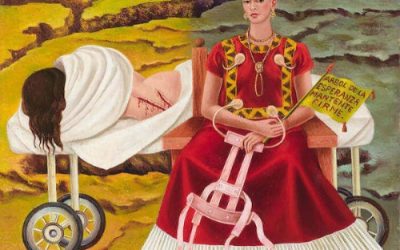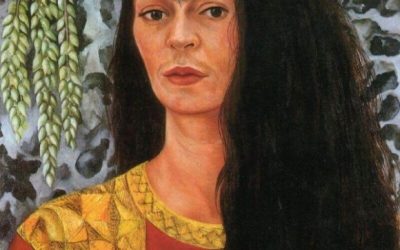
Without Hope by Frida Kahlo
Frida Khalo (1907-1954) Thanks to her intensely colorful and often terrifying self-portraits, Khalo has become one of the most famous painters in history. Frida spent most of her life in Mexico City. It was there at the age of 18 that she suffered a traffic accident that caused multiple injuries that left her disabled for life and caused her great pain. He began painting during the initial convalescence. In 1929 she married Diego Rivera, the most famous painter of the moment in Mexico. Their relationship was stormy (they divorced in 1939 and remarried in 1940) but it lasted until her death. Apart from painting, politics was their shared passion, as they were both militant communists. Her posthumous reputation has grown so fast since the 1980s that her face now adorns articles of all kinds and her extravagant attire has made her a fashion icon.
Few painters have produced work as intensely autobiographical as the Mexican Frida Khalo: 150 of her paintings are known, and more than a third are self-portraits. Some of them are fairly conventional images, but many others take a different approach: they are personal comments on the physical and emotional pain of his life. Without hope represents the artist lying in bed in the middle of a barren landscape, with a repulsive funnel full of various meats and fish suspended over her mouth. Although small in size, this is one of the most powerful and disturbing paintings. It is an autobiographical painting as Khalo’s medical problems were mainly a result of the terrible injuries received (on the spine, pelvis and other parts of the body) in a tram accident in 1925, while he was still in school. Even before the accident, Frida was limping due to childhood polio, and later suffered from digestive problems and alcoholism. By the time she painted Hopeless, her lack of appetite had caused her to lose such weight that she had to be funnel-fed. It takes on monstrous proportions in the work—so much so that a wooden frame is needed to support it—and it’s filled, not with ground-up food, but with a heap of dead meat.
An inscription by Kahlo’s hand on the back of a painting gives the work its title: “I don’t have the slightest hope left…Everything moves to the beat of what my belly holds.” Although her work had numerous admirers, in Khalo’s life she was left in the shadow of her husband, the painter Diego Rivera, a man with a personality as enormous as his size. Her paintings used to be small and intimate, he specialized instead in the creation of large murals for public buildings, the field in which Mexico made its most characteristic contribution to modern art. Hopeless features the “banquet of death” represented by a large funnel overflowing with a nauseating mixture of meat, fish, and fowl. It is probable that Khalo got the idea of the funnel as an instrument of torture (which in this painting it seems to represent) from a book on the Spanish Inquisition that he had in his library. On top of the pile of food is a sugar skull with Khalo’s name inscribed on it. These skulls are very common in the Mexican holiday of the Day of the Dead, on November 2. In this celebration that combines Aztec and Christian elements (it coincides with the feast of All Saints), Mexicans honor deceased relatives and friends.
The skull is an obvious allusion to death; sugar, on the other hand, represents the sweetness of life. Khalo’s sorrowful face gazes at the viewer with an imploring expression and tears running down her cheeks. Only the head and one shoulder stick out from under the bedclothes, which conveys a sense of constriction. The truth is that Khalo had to spend a lot of time in bed with a back brace. Throughout his life he had to undergo more than thirty surgeries. The quilt is a kind of shroud and is adorned with curious designs. In her book Frida, a biography of Frida Khalo (1983), the American art historian Hayden Herrera proposed that the circular forms are unfertilized cells and ovules and interpreted them in opposition to the images of the Sun and the Moon present in the painting, the microscopic world in front of the Solar System.
MOON presides over the table, one on each side the Moon and the Sun. These stars have been interpreted in many different ways; for example, as a fear of indicating that Frida’s pain does not rest and persists throughout the day and night. Or the pale Moon, a traditional feminine motif that has sometimes been interpreted as a symbol of the fragile Khalo herself, whose faint light would be a reflection of the great burning Sun.
Frida Kahlo painting Without Hope
SUN. The painter had a passionate interest in pre-Columbian Mexican culture in which the cult of the Sun played an important role. This sometimes appears in her paintings as a symbol of life-giving energy, but here it could be a more specific allusion to her husband Diego Rivera, a man of great vigor and self-confidence. As for Kahlo’s technique, it must be said that she was basically self-taught and her working methods reflect the unusual circumstances of her life. She began to paint seriously while recovering from the 1925 accident. A special easel was attached to her bed and He put a mirror on top of the ceiling, so that she could see herself when she was lying down and serve as a model for herself. His brushwork was delicate and skillful, but in his last years, affected by alcoholism, it became rougher.



